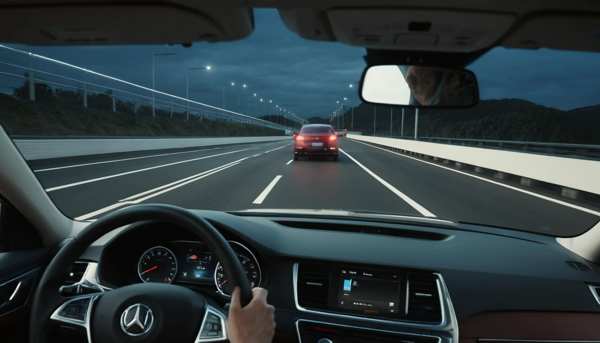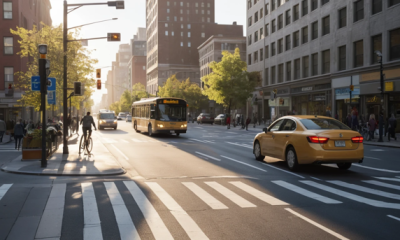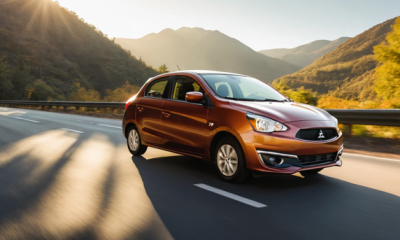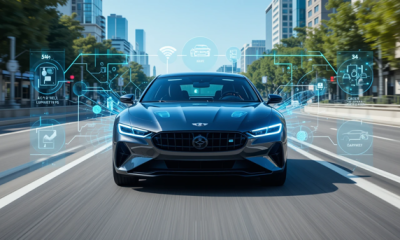Tech
How Does Blind Spot Monitoring Work? – Smart Safety Boost

How Does Blind Spot Monitoring Work: Blind spot monitoring helps avoid crashes by spotting hidden vehicles. Learn how it works and why it’s a must-have.
How Does Blind Spot Monitoring Work? 🚘
Ever changed lanes and suddenly heard a horn blare from a car you didn’t see? 😳 That’s your blind spot catching you off guard. But modern cars come with something clever to help—blind spot monitoring. But how exactly does this technology work? Let’s break it down together.
Blind spot monitoring (BSM) uses sensors and cameras to detect vehicles in areas your mirrors can’t see. If a car is in your blind zone, a light or alert goes off, warning you not to switch lanes. Pretty cool, right?
Let’s dig into the details and see how this life-saving system actually works—and why it matters.
What Is a Blind Spot? 👀
A blind spot is the area around your car that isn’t visible through your mirrors or windows. These hidden zones vary by vehicle size but often sit:
- Behind the rear pillars
- Along the sides of the vehicle
- In areas too narrow for mirrors to capture
Blind spots are dangerous because you can’t react to what you can’t see.
Why Blind Spots Are a Big Deal ❗
Thousands of accidents happen every year because drivers fail to spot cars in their blind zones. BSM helps prevent:
- Unsafe lane changes
- Side-swipe collisions
- Merging mishaps
BSM is like an extra pair of eyes, always watching when you can’t.
The Tech Behind Blind Spot Monitoring 🧠
Blind spot systems rely on radar sensors, ultrasonic sensors, or cameras. These are typically installed:
- In rear bumpers
- On side mirrors
- Around the rear quarter panels
Here’s a quick look at what each type does:
| Sensor Type | Function | Common Use Area |
|---|---|---|
| Radar Sensors | Detect speed and distance of nearby vehicles | Rear corners |
| Ultrasonic Sensors | Sense objects close by | Side mirrors or bumpers |
| Cameras | Provide real-time video feedback | Rear-view monitoring |
How Blind Spot Monitoring Works 🔍
Here’s how the process usually plays out:
- Sensors activate when your vehicle is moving.
- Objects in blind zones are detected in real-time.
- Visual warning lights appear on side mirrors.
- Some systems add audio or vibration alerts if you signal a lane change.
If a car lingers in your blind zone, the system lets you know before it’s too late.
Visual vs. Audible Alerts 🎯
Most systems use small warning lights in your side mirrors. But others add:
- Beeping sounds
- Steering wheel vibrations
- Seat alerts
Some high-end cars even auto-correct steering to avoid collisions!
Cars That Come with BSM Preinstalled 🚗
Many modern vehicles come with BSM. This includes brands like:
- Toyota
- Honda
- Ford
- Hyundai
- Subaru
They offer it in safety packages. For example, Toyota Safety Sense or Honda Sensing.
Here’s a list of popular models:
| Vehicle Model | Blind Spot Monitoring Included? | Notes |
| Toyota RAV4 | Yes | Standard on most trims |
| Honda CR-V | Yes | Often bundled with extras |
| Ford Escape | Yes | Optional in base trims |
| Hyundai Tucson | Yes | SmartSense suite |
| Subaru Forester | Yes | Part of EyeSight tech |
What Happens If BSM Detects a Vehicle? 🚨
If a vehicle enters your blind zone, the system acts fast:
- A small orange or red icon lights up
- If you signal to change lanes, alerts get stronger
- Some systems will even nudge the steering back
You stay in control—but better informed.
Blind Spot Monitoring vs. Lane Change Assist 🆚
Though often mixed up, they’re different:
| Feature | Main Function |
| Blind Spot Monitoring | Detects vehicles in blind zones |
| Lane Change Assist | Alerts during attempted lane changes |
Some cars combine both for even more safety.
Benefits of Using BSM 💡
Here’s why blind spot monitoring is worth it:
- Reduces stress during lane changes
- Increases driver confidence
- Lowers accident risk
- Protects passengers
- Enhances overall road awareness
Limitations to Be Aware Of ⚠️
No system is perfect. BSM may struggle in:
- Heavy rain or snow
- Extreme glare or darkness
- Narrow city streets
Always use your mirrors and turn your head, even with BSM.
Can You Add BSM to Older Cars? 🔧
Yes! Aftermarket kits are available. They include:
- Sensors for bumpers or mirrors
- LED indicator lights
- Control modules
Costs range from $300–$800 depending on features.
Is BSM Worth the Price? 💸
In short—yes. For the price of one insurance deductible, you gain:
- Extra visibility
- Peace of mind
- Accident prevention
If you’re leasing or financing, BSM can even reduce your insurance premium.
Tips for Using BSM Effectively ✅
Stay safe with these tips:
- Don’t ignore alerts—they’re not just suggestions
- Always use your mirrors and check over your shoulder
- Clean your sensors often
- Know what alerts mean in your car
Future of Blind Spot Tech 🔮
The future is even smarter:
- 360° vision systems
- AI-based driver behavior analysis
- Augmented reality HUD alerts
Some cars may soon talk to nearby vehicles to improve BSM accuracy.
Final Thoughts on BSM 😊
Blind spot monitoring is more than a luxury—it’s a safety game-changer. It uses smart sensors and alerts to keep drivers safe.
It’s great for new drivers and those with lots of experience.
FAQs
How does blind spot monitoring alert the driver?
It shows warning lights, beeps, or vibrates when a vehicle is in your blind zone.
Can blind spot monitoring work at night?
Yes, most systems use radar that works in darkness or low light.
Do all cars have blind spot monitoring?
No, it’s standard in many newer models but not universal yet.
Can I install blind spot monitoring in my old car?
Yes! Aftermarket BSM kits are available and relatively affordable.
Is blind spot monitoring worth the extra cost?
Absolutely—especialy if you drive on busy highways or in dense traffic.
References
-

 Driving Tips4 weeks ago
Driving Tips4 weeks agoDefensive Driving Techniques for City Traffic – Proven Smart Tips
-

 Driving Tips4 weeks ago
Driving Tips4 weeks agoHow To Drive A Manual Transmission – Master The Skill Fast!
-

 Driving Tips3 weeks ago
Driving Tips3 weeks agoTips For Long Distance Solo Driving – Expert Secrets For a Smooth Ride
-

 Energy Efficient3 weeks ago
Energy Efficient3 weeks agoMost Fuel Efficient Non Hybrid Car – Top Pick With Amazing Value








